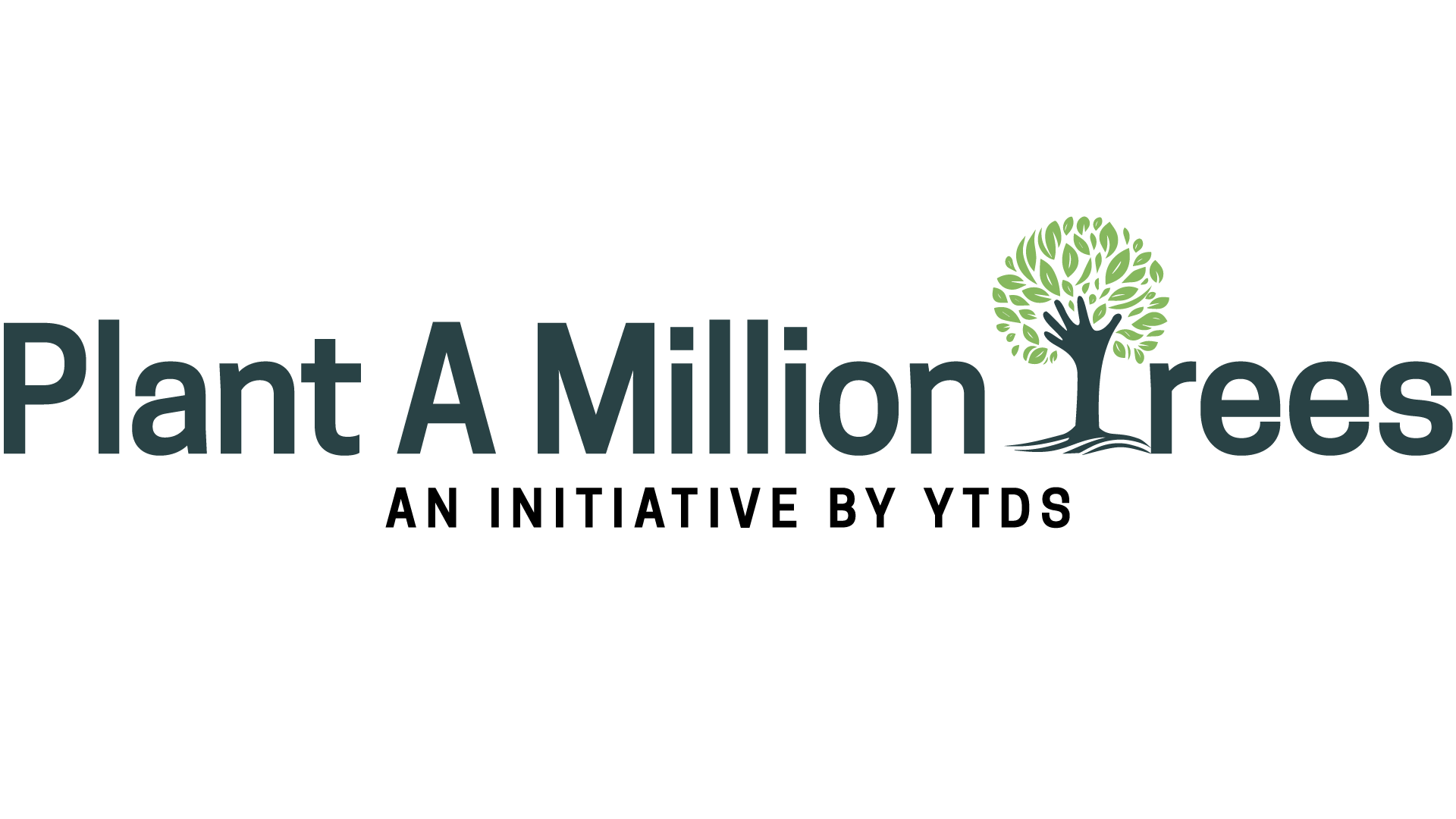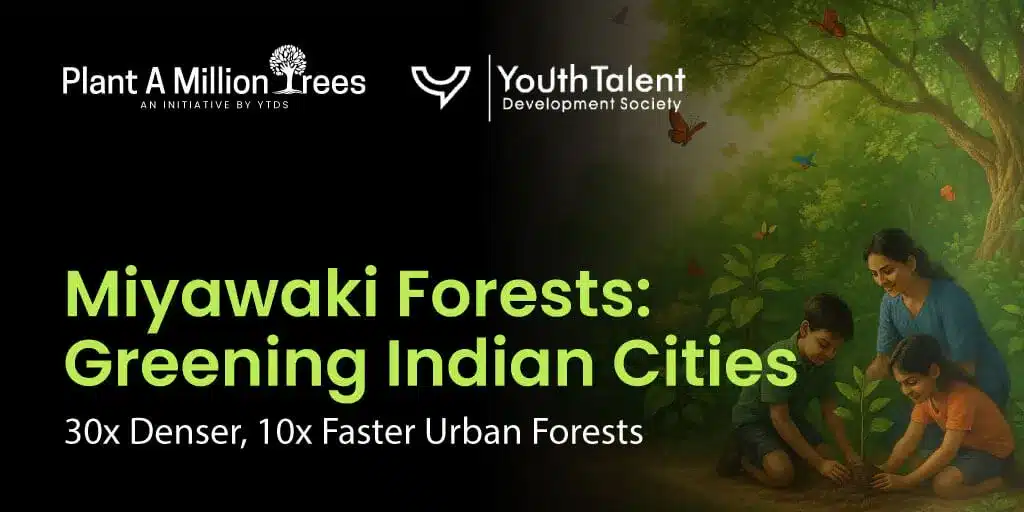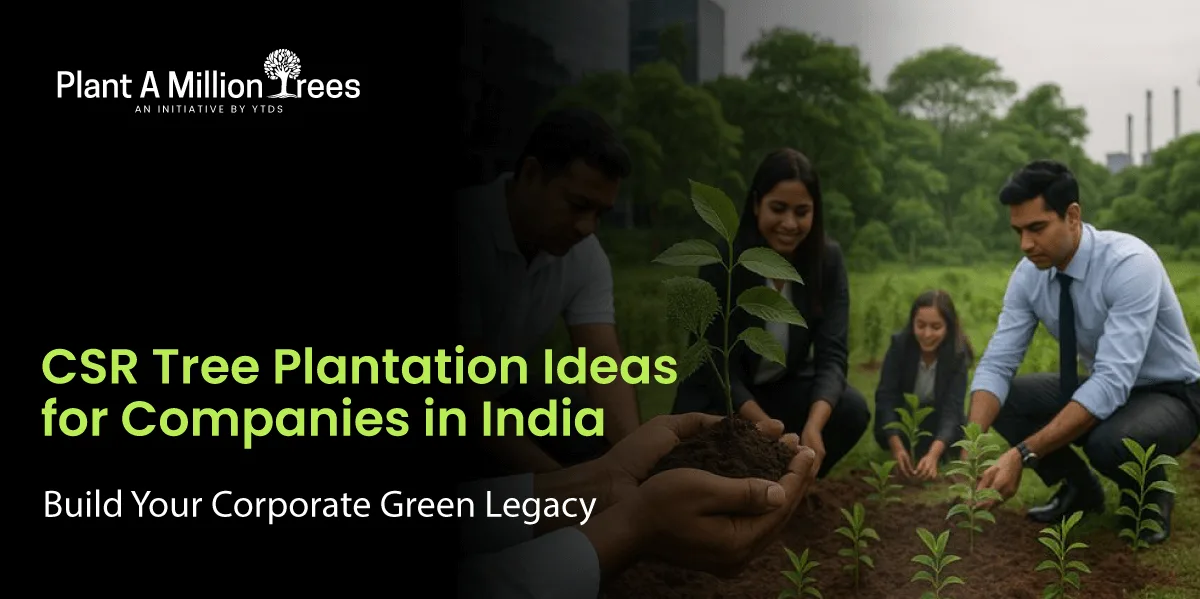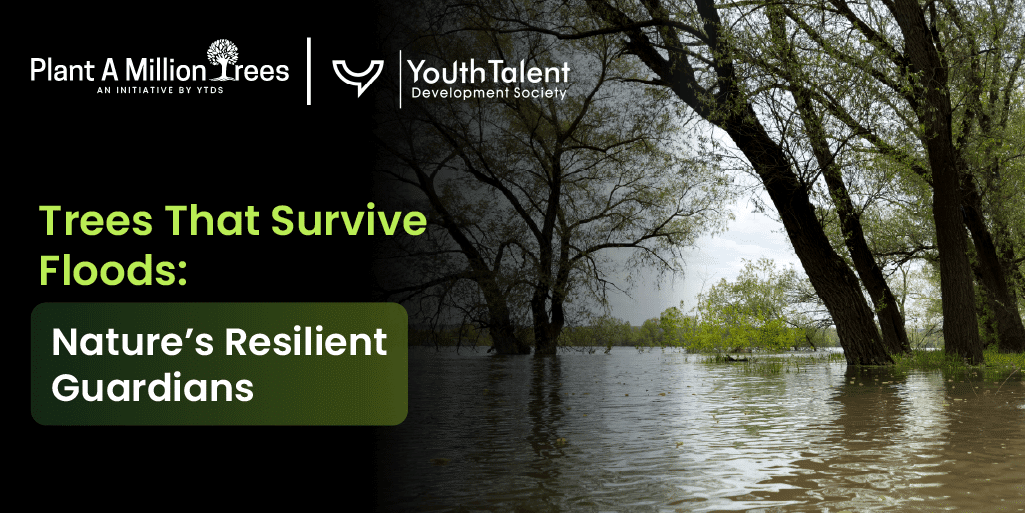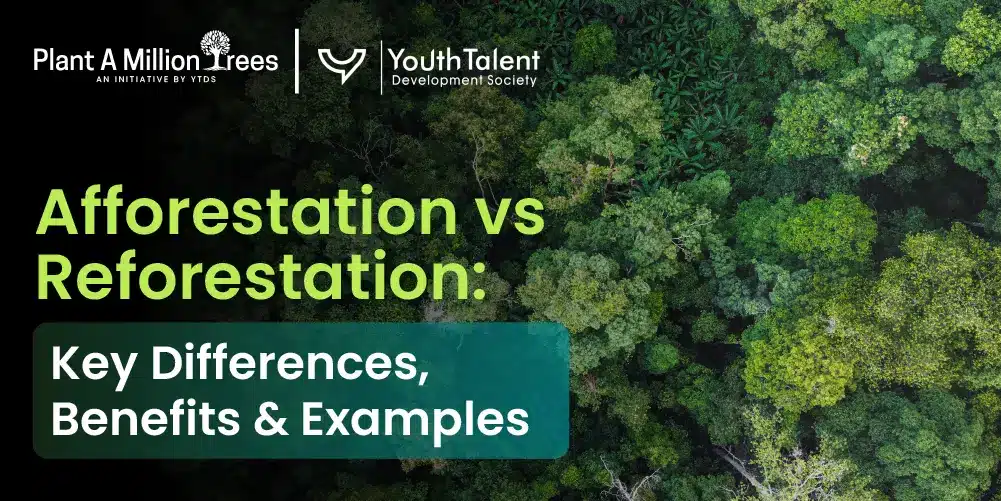India is at a crossroad of corporations. The Corporate Social Responsibility (CSR) is no longer a goodwill thing that...
Take a stroll through any Indian metropolis nowadays, be it in Delhi, Bengaluru, Chennai or Mumbai, and you will probably feel overwhelmed by the preponderance of concrete.
Towers are getting taller every year, streets are getting wider and wider, and malls are covering acres of space. What is lacking, though, is often the most obvious requirement, which is trees.
Urbanization has stolen away huge areas of green cover and we are left with increasingly smaller parks and polluted skies. The price is evident–heat waves increase, the burden of mental illnesses grows, and biodiversity is moving towards extinction.
It is against this background that the idea of the Miyawaki forest India has become a new revolutionary reaction. It is not just any plantation drive; it is a fast, scientifically proven method of planting greenery in the tiniest of areas.
The Miyawaki technique gives Indian cities a chance to fight against environmental degradation by developing mini forests 30 times more dense than conventional plantations and growing 10 times faster.
On corporate grounds, on school grounds, in airports, in residential societies, Miyawaki forests are sprouting like green miracles, reinventing the meaning of what urban afforestation can be.
This blog goes in-depth on the Miyawaki movement in India, what it is, why it is a more important movement now than ever before, the positive results it provides, real examples of successes, and how to build one in your local area.
What Is a Miyawaki Forest? The Method Explained
The Miyawaki system is named after Akira Miyawaki, the Japanese botanist, and involves the reconstruction of native forests in a small area.
The Miyawaki forests focus on biodiversity and density as opposed to traditional plantation drives where similar saplings are usually planted. Here’s how it works:
- Native Species Selection: rather than importing exotic plants, native species adapted to the environment are selected–this guarantees survival, stability, and an ecosystem in balance.
- Dense Planting: The trees are spaced close to each other, 3-5 saplings per square meter, and it resembles the conditions in the natural forest.
- Layered Canopy Design: The plantation is a mix of shrubs, sub-trees, canopy trees and taller emergent species. This is a multilayer structure which is a replica of real forests.
- Preparation of the soil: This is done by adding organic biomass, perforators, and water traps to the soil to speed up the growth of the roots.
- Quick Growing Cycle: Due to the density and soil treatment, Miyawaki forests are grown 10 times faster than normal plantations.
The result? A healthy urban thick forest that will mature in 20-30 years rather than a typical 100. Such forests need no management after 2-3 years and can sustain themselves.
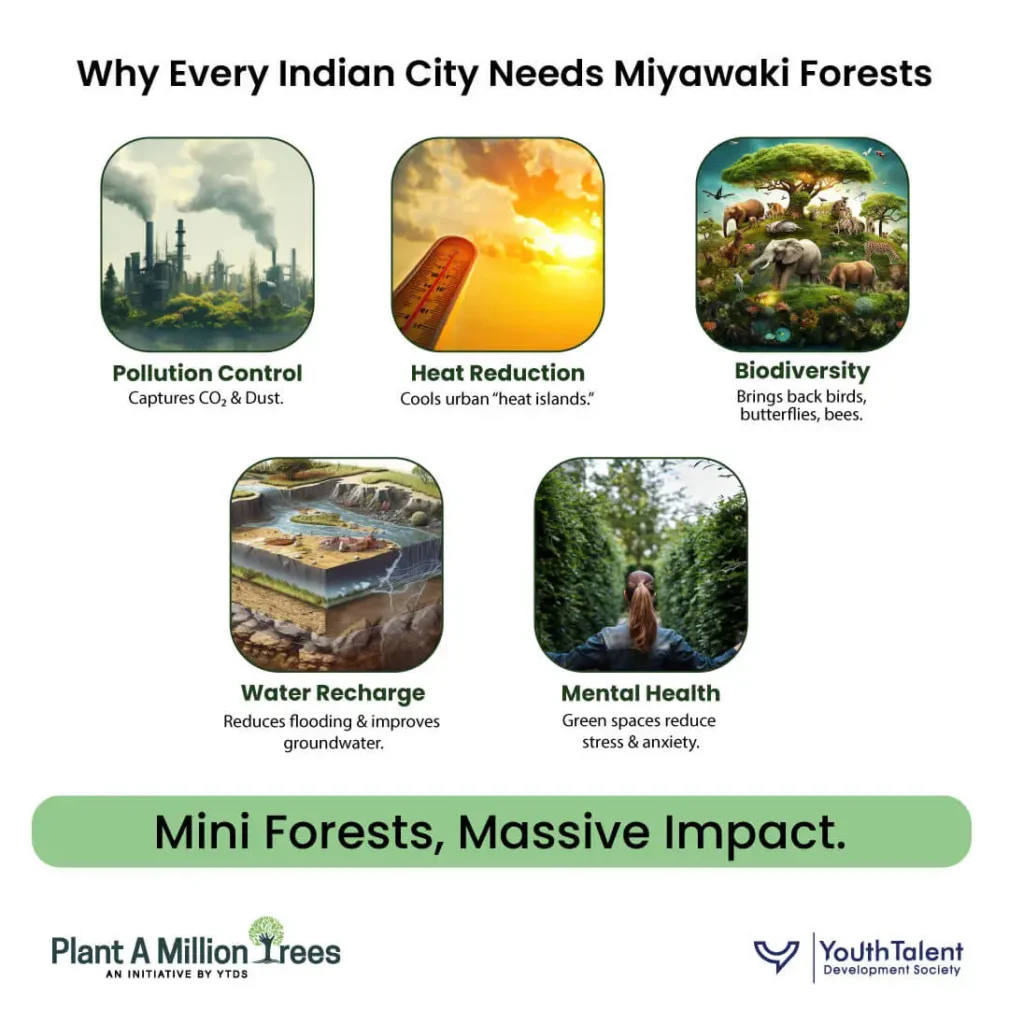
Why India Needs Miyawaki Forests Now: The Urgency of Urban Green Spaces
The cities of India have a green crisis. The number of trees per human being is very low in relation to the population density and the speed at which the population is growing. These city problems:
- Air Pollution: Delhi and Lucknow often have air quality indices in the range of hazardous. Lush vegetation captures carbon and particulates that enhance breathable air.
- Heat Islands: Some urban areas such as Ahmedabad and Hyderabad are usually 3-5degC hotter than the surrounding countryside because of concrete absorbing heat. These heat islands are also cut down by mini forests.
- Mental Health Strain: The life in the city is hectic. There are scientific researches that support the idea that even modest green areas ease anxiety, depression and cognitive exhaustion.
- Fading Away: Pigeons and crows take control of cities and other bird species disappear. Miyawaki forests help to bring back butterflies, bees and various birds into city life.
- Flooding & Water Runoff: Concrete surfaces impede natural absorption resulting to waterlogging. Thick mini forests enhance recharge of ground water.
As we see, the cities of India cannot be sustained without ambitious greening policies. Miyawaki forests are specifically adapted to urban settings–they can be easily placed in small areas yet produce disproportionately large environmental and social benefits.
Proven Benefits of Miyawaki Forests: More Than Just Trees
A Miyawaki forest India is not a bunch of trees, but a living infrastructure that redefines environments. These advantages are ecological, health-related, and social:
- Fast-Growing Forests: Miyawaki forests grow conspicuously in 2-3 years, as opposed to traditional plantations, which require decades to show growth.
- Aid in Sound Muffling: With the thick vegetation cover, there is less sound pollution either traffic or industrial sound in metropolis.
- Biodiversity Revival: (Planting many native species) The forests soon become home to birds, butterflies, insects and even small mammals.
- Carbon Absorption: A 100 square meter Miyawaki patch has the ability to absorb 30 times the amount of carbon than a lawn of equivalent size.
- Creation of microclimate: These forests cool the surrounding environment, and therefore act as hot spots of relief during heat waves.
- Social Impact: Grown in schools, parks or residential complexes, they create a sense of community pride and community participation as well as environmental education.
Ecology is not the only beneficiary of the Miyawaki plantation, healthier, happier cities are also the result.
Miyawaki Forests in Indian Cities: Real Success Stories
Miyawaki forests have already achieved amazing outcomes in India. Here are some key examples:
- Chennai Airport: In 2019 a Miyawaki forest was planted on airport land. More than 6000 saplings had grown within two years, which minimized noise pollution in the area and beautified it.
- Pune: Pashan Lake: Pashan Lake had previously faced a problem of encroachment, but with a biodiversity-enhancing move that involved planting Miyawaki forests near the water body, it has come back to life.
- Delhi Ridge: Sections of the beloved ridge in the capital are being reinstated with Miyawaki techniques, which are bolstering the lungs of the capital against pollution.
- Corporate CSR Projects: Miyawaki plantations have also been integrated into the sustainability program of companies such as Toyota, Infosys and Mahindra as part of green projects on barren land near their offices.
- Schools and Communities: Schools and housing societies across Gurugram to Bengaluru are planting Miyawaki forests to provide children with experience on how to be environmental custodians.
Other organizations such as the Youth Talent Development Society (YTDS) are also doing their bit as they collaborate with schools and local authorities to plant pocket forests in residential and semi-urban settings.
How to Create a Miyawaki Forest in India: A Step-by-Step Guide
In the event that you are moved to act, here is a dumbed-down guide on how to develop a Miyawaki forest in India:
- Space – Sufficient are 100-200 square meters of vacant territory.
- Soil Preparation – Loosen the soil 1 meter deep and add compost, perforators (such as rice husk) and water retainers (such as cocopeat).
- Select Native Species – Study 20-30 native species common in your area (shrubs, canopy trees, emergents).
- Plant Densely – In a natural competition, vegetation is planted with 3-5 saplings per square meter.
- Mulching – Biomass over the soil to keep it moist and weed free.
- Watering and Maintenance – During the initial 23 years of planting, water and protect saplings with fencing.
- Step Back – Once the forest has been properly taken care of, it is self-sufficient.
These measures make Miyawaki forests available to citizens throughout India, whether in a schoolyard, corporate campus, or community park.
Schools, NGOs & CSR in Miyawaki: Who’s Making This Possible?
Schools, non-profits, and corporate sponsors are working together to restore Miyawaki forests in India, which are already thriving.
- Schools: The concept has been exposed to children in programmes in Pune and in Gurugram, combining sustainability with education.
- NGOs: Non-governmental organizations such as Afforestt and YTDS (Youth Talent Development Society) help communities to establish pocket forests, teaching the Miyawaki technique to volunteers.
- Corporate CSR: Tata steel and Wipro are corporations that support biodiversity by financing large-scale plantations along industrial areas to offset their emissions.
This is a government-corporate partnership that will help to scale Miyawaki forests.
Challenges & Myths Around Miyawaki Forests
Though the movement is picking up momentum, there are certain criticisms and myths about it:
- Incestuous: Critics say that it is not natural to have so many trees planted in such a small area. In practice, the technique imitates the density of natural forests–only faster.
- “High Cost”: Soil preparation and soil density may be costly in the start, but the cost is offset many times over in the long run.
- “Poor Survival Rates”: There is a concern the saplings will die. However, in cases of local species selection, success rates are over 85-90%.
- Maintenance Burden: During the initial 2-3 years of protection and watering these forests are self-sustaining.
One should distinguish between stereotypes and real-life issues, like where to get enough land in densely populated urban areas or how to get people involved.
FAQs on Miyawaki Forests in India
What is wrong with the Miyawaki method, compared to regular plantations?
It focuses on indigenous species, compact planting and multiple-layered growth resulting in forests that are 30 times more compact and 10 times quicker to grow.
How to plant a Miyawaki forest at home or in a community in India?
Plant native species in high density, identify land, prepare soil, and maintain 2-3 years to the time when it becomes self-sufficient.
What are the principal Miyawaki plantation advantages?
Swift increase, restoration of biodiversity, increase in carbon, decreasing noise and the establishment of cooling microclimates in urban landscapes.
Is it possible to have Miyawaki forests in small urban areas?
Yes, there is a possibility of a mini forest even on 100 square meters. It has been adopted in many Indian schools and housing societies.
Who is in favour of Miyawaki forests in India?
CSR through NGOs, schools and corporates. Some groups, such as YTDS, advocate the planting of Miyawaki forests within their green agenda.
Conclusion: Greening the Future, One Mini Forest at a Time
The Miyawaki forest India trend is not an environmental trend–it is a need. Our cities are on the edge as pollution, heat waves, and loss of biodiversity increase. The Miyawaki approach provides an efficient, scaled and promising solution to regain urban balance.
If every school had its mini forest, every corporate campus invested in thick planting and every municipality marked out pocket forest areas. Combined, these initiatives would help reshape the urban environment in India as green, breathable, resilient ecosystems.
The time is now. The idea is to plant your own Miyawaki patch whether you are an individual, a housing society, or a corporation. It can seem as a little thing nowadays, but repeated among millions of citizens, it can become the future of Indian cities.
